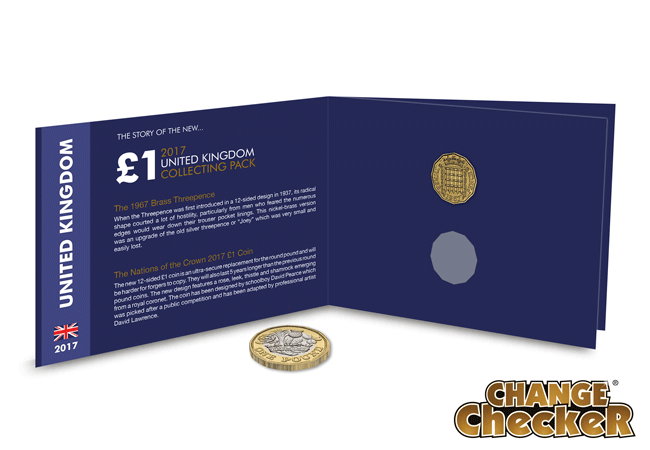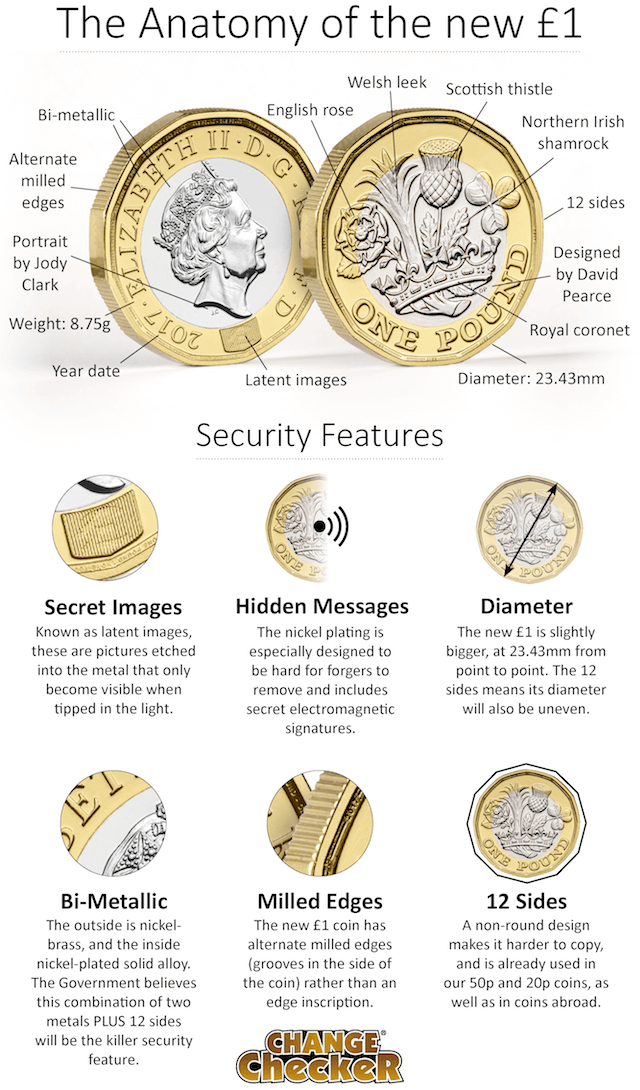£1 Coins
The Anatomy of the new 12-sided £1 Coin
Tomorrow the new £1 coin will be released into circulation around the UK, sparking a new flurry of interest in coins from the general public.
Just like the polymer fiver back in September, the new £1 is sure to create excitement across the UK as people get their hands on the new coins for the first time.
So here’s what to look out for when you find one:
It’s also worth looking out for the date on your £1 when you find one in your change. The Royal Mint have confirmed that at least 1.4 billion £1 coins in total will enter circulation, but half a billion of these £1 coins will be dated 2016.
When you do find your first pound make sure you post a picture on Facebook, Twitter or Instagram using the hashtag #foundapound, and also tag the location you found it!
Poll: What is your favourite £1 Coin Design? – Northern Ireland
 As part of the Great One Pound Coin Race, we want to find out Britain’s ultimate favourite £1 coin.
As part of the Great One Pound Coin Race, we want to find out Britain’s ultimate favourite £1 coin.
Last week we asked you to vote for your favourite Scottish £1 coin design – over 30% of Change Checkers voted for the 2011 Edinburgh £1.
This week we want to know your favourite Northern Irish £1 coin design.
Let us know by voting in our poll below:
More information about the Northern Ireland £1 coin designs
The first reverse design series of £1 coins took floral emblems as its theme to represent the United Kingdom and its four constituent countries. They were designed by Leslie Durbin – one of the most highly-regarded silversmiths of the 20th Century. The Flax plant is used on this coin to represent Northern Ireland.
The second series of £1 coin designs used heraldic emblems to represent the United Kingdom and its four constituent countries. This coin features the Broighter collar over a Celtic Cross to represent Northern Ireland. The Broighter collar was discovered in 1896 amongst a hoard of gold Iron Age artefacts near Lough Foyle in Northern Ireland, and is said to be the finest example of Irish La Tène goldworking in Europe.
N.I: Egyptian Railway Arch Bridge
The third series of £1 coin designs depicts bridges from each of the four consituent countries in the United Kingdom. This coin features the Egyptian Arch Railway Bridge to represent Northern Ireland. The Egyptian Arch is a railway bridge in Newry, Northern Ireland which gained its name from its resemblance to the headdress worn by ancient Egyptian Pharaohs.
The fourth series of £1 coins used the capital cities of the four constituent countries as the basis of the reverse design. Designed by Stuart Devlin, Goldsmith and Jeweller to the Queen, this coin depicts the circular Coat of Arms of Belfast as the principal focus to represent Northern Ireland.
The fifth series of £1 coin designs uses pairs of floral emblems designed by Timothy Noad to represent the United Kingdom and its four constituent countries. This coin features a flax alongside a shamrock to represent Northern Ireland.
Next week- Part 4: What’s your favourite Welsh £1 coin design?
 This could be your last chance to secure Britain’s last ’round pound’.
This could be your last chance to secure Britain’s last ’round pound’.
If you want to get your hands on the last ‘round pound’ they are available here protectively encapsulated and certified as superior Brilliant Uncirculated quality.
50 years in the making – from 3d to £1: the story behind the new £1 coin
In just a few weeks, Britain’s one pound coin will undergo a major makeover. The familiar round pound will change to become bi-metallic and 12-sided and will also have several new security features. But the shape of this new £1 coin is actually a throwback to the thrup’nny bit – an old favourite from the pre-decimal era.
The 12-sided threepenny is fondly remembered for its individuality. There was quite literally nothing like it before, and it holds the proud title of Britain’s first non-circular coin.
But, of course, it’s not the first major change in the nation’s £1.
I’ve taken a look back at some of the key changes for Britain’s coinage over the last 50 years to welcome the brand new 12-sided £1 coin, when it is issued on 28th March.
The 28th March 2017 is sure to become a historic day as we welcome the new coin which has been billed to become the most secure circulating coin in the world. This will be the first specification change to our £1 coin in more than 3 decades.
But the Thrup’nny Bit deserves recognition for being the inspiration behind our new £1 coin which is sure to become a collecting sensation. The Thrup’nny Bit was eventually withdrawn from circulation in 1971 after the introduction of decimal coinage which didn’t include Three Pence as a denomination. However, its legacy lives on, and is still widely regarded as one of the most iconic coins in British history.
 The Story of the new £1 Collector’s Pack
The Story of the new £1 Collector’s Pack
Click here to secure the ‘Story of the £1 Collector Pack’ which has space for you to house the new 12-sided £1 coin once you find it in your change, alongside the UK Brass 12-Sided Threepence Coin.







